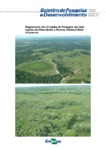Please use this identifier to cite or link to this item:
http://www.infoteca.cnptia.embrapa.br/infoteca/handle/doc/901967| Title: | Mapeamento das unidades de paisagem das sub-regiões da Nhecolândia e Poconé, Pantanal Mato-Grossense. |
| Authors: | RAVAGLIA, A. G.  SANTOS, S. A.   SORIANO, B. M. A.   DANIEL, O.   FREITAS, L. C. de   PELLEGRIN, L. A.   TOMAS, W. M.   RODELA, L. G.   BUENO SOBRINHO, A. A.   ARAUJO, M. T. B. D.   |
| Affiliation: | ADRIANA RAVAGLIA GAMARRA, UFMS; SANDRA APARECIDA SANTOS, CPAP; BALBINA MARIA ARAUJO SORIANO, CPAP; OMAR DANIEL, UFGD/FCA; LEILANE CRISTINE DE FREITAS, UFMS; LUIZ ALBERTO PELLEGRIN, CPAP; WALFRIDO MORAES TOMAS, CPAP; LUCIANA GRACI RODELA, USP; ANTONIO ARANTES BUENO SOBRINHO, CPAP; MARCOS TADEU BORGES DANIEL ARAUJO, CPAP. |
| Date Issued: | 2011 |
| Citation: | Corumbá: Embrapa Pantanal, 2011. |
| Pages: | 15 p. |
| Description: | O mapeamento apresentado sintetiza as principais unidades de paisagens das sub-regiões da Nhecolândia e de Poconé, no Pantanal brasileiro. Os mapas baseiam-se na identificação de formações vegetais dominantes conforme o grau de inundação. Observou-se que a sub-região da Nhecolândia é dominada por formações savânicas sazonalmente inundáveis (41%) e a sub-região de Poconé é dominada por formações florestais sazonalmente inundáveis (26%). O domínio de florestas em Poconé deve-se principalmente ao domínio do cambará (Vochysia divergens). Ambas as sub-regiões apresentaram extensas áreas de savanas. As pastagens nativas de melhor qualidade estão localizadas nas áreas inundáveis, embora nessas áreas haja predominío de espécies cespitosas de baixo valor nutricional como Andropogon hypogynus. Em ambas as sub-regiões observaram-se dominância de áreas savânicas sazonalmente inundáveis, o que mostra a dinâmica destas áreas com espécies arbustivas adaptadas ao ciclo de inundação. The map presented here contains the main landscape units of the Nhecolândia and Poconé sub-regions of the Pantanal wetland. The map is based on the identification of dominant vegetation types and the flooding degree. The Nhecolândia sub-region was dominated by savannas seasonally flooded formations (41%) and the Poconé sub-region was dominanted by seasonally flooded forests (26%). The domain of forests was mainly due to cambará (Vochysia divergens). Both sub-regions presented extenses savanna areas. Higher quality natural pastures were situated on the flooding areas, mainly on lower relief. In the intermediate areas, there is dominance of lower quality cespitous species as Andropogon hypogynus. In both sub-regions, there was dominance of savanna seasonally flooded formations, which shows the dynamic of these areas with woody speciess adapted to flooding cycle. |
| Keywords: | Formações vegetais Pastagens nativas Savanas Vegetal formations Natural pasture Savanna |
| Series/Report no.: | (Embrapa Pantanal.Boletim de Pesquisa e Desenvolvimento, 105). |
| Type of Material: | Folhetos |
| Access: | openAccess |
| Appears in Collections: | Boletim de Pesquisa e Desenvolvimento (CPAP)  |










